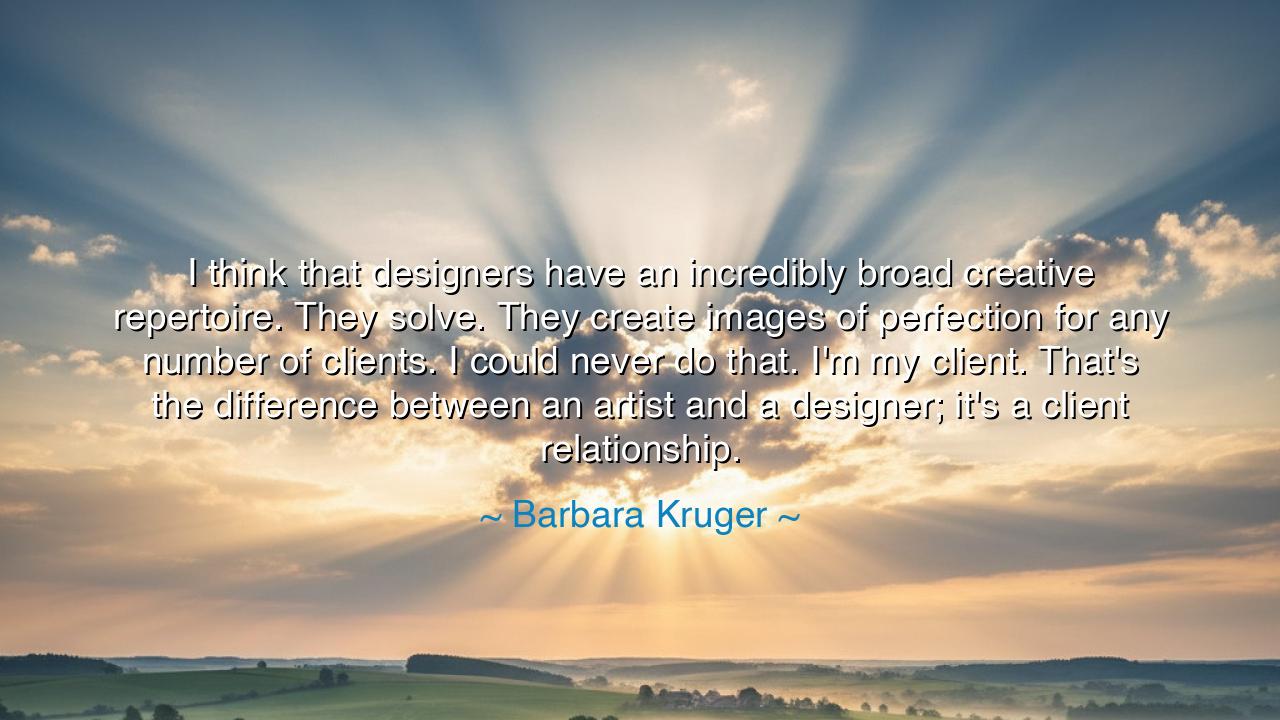
I think that designers have an incredibly broad creative
I think that designers have an incredibly broad creative repertoire. They solve. They create images of perfection for any number of clients. I could never do that. I'm my client. That's the difference between an artist and a designer; it's a client relationship.






In the realm of creation, two paths emerge: one guided by personal vision, the other shaped by the needs of another. Barbara Kruger speaks to this distinction when she declares, “I think that designers have an incredibly broad creative repertoire. They solve. They create images of perfection for any number of clients. I could never do that. I’m my client. That’s the difference between an artist and a designer; it’s a client relationship.” These words illuminate the ancient tension between service and self-expression, between the shaping of one’s own voice and the molding of forms for the desires of others.
To solve and create images of perfection is the mark of the designer. Kruger honors their craft, for it requires flexibility, skill, and a mind attuned to the visions and needs of many. The designer’s brilliance lies in their ability to step into another’s world, to manifest ideals not of their own choosing, and to translate them into forms that resonate. This is a labor of empathy and precision, demanding mastery of technique and the capacity to adapt.
Yet the artist walks a different path. Kruger declares that she herself is her client, and in this lies the essence of her work: authenticity. Where the designer bends to the expectations of others, the artist listens only to the inner voice, translating personal experience and conviction into form and image. Here, creation becomes an act of courage, for it bears no guarantee of approval, only the imperative to express truth.
The origin of this distinction is as ancient as the first artisans who adorned temples and the first poets who spoke from the soul. Across civilizations, the craftsman served kings, patrons, or the market, while the visionary spoke from within, guided by vision rather than request. Kruger’s insight echoes this age-old wisdom, reminding us that art and design, though intertwined in skill, are separated by the nature of the relationship they hold with the world.
Thus, let this teaching endure: honor the work of the designer, for it shapes beauty to serve others, but recognize the freedom of the artist, who listens solely to the call of the self. In the balance between service and self-expression lies the eternal tension of creation, a lesson for all who seek to shape form, thought, or soul across the ages.






CNQuyet Chi Nguyen
Barbara Kruger’s perspective makes me wonder if designers feel like they give up their artistic freedom for the sake of the client’s vision. On the other hand, being a client yourself, like the artist, allows for complete control. I’ve always thought that the client relationship is what defines good design, but do you think it can stifle the raw creativity of a designer if they always have to cater to others’ expectations?
JWJii Win
This idea of being your own client versus solving someone else’s needs is interesting. As a designer, I sometimes feel that there’s a conflict between my personal vision and the expectations of a client. But at the same time, fulfilling a client’s needs can be just as creatively fulfilling. How do you balance staying true to your creative instincts while still delivering what the client wants?
KLNguyen Thi Khanh Linh
I love the way this quote highlights the difference between an artist and a designer, but I wonder if it’s too rigid. Isn’t there room for designers to be their own clients sometimes, especially when they’re working on personal projects? Could it be that the line between artist and designer is becoming less clear, especially in the world of freelance and digital work?
DHDo Dieu Hang
This quote really made me reflect on the difference between art and design. While both involve creativity, I can see how design is much more client-focused, and the artist’s work is more personal. Do you think designers lose some of their artistic freedom because they have to meet the needs of clients? Or do you believe that designing for a client can also bring out a new form of creativity?